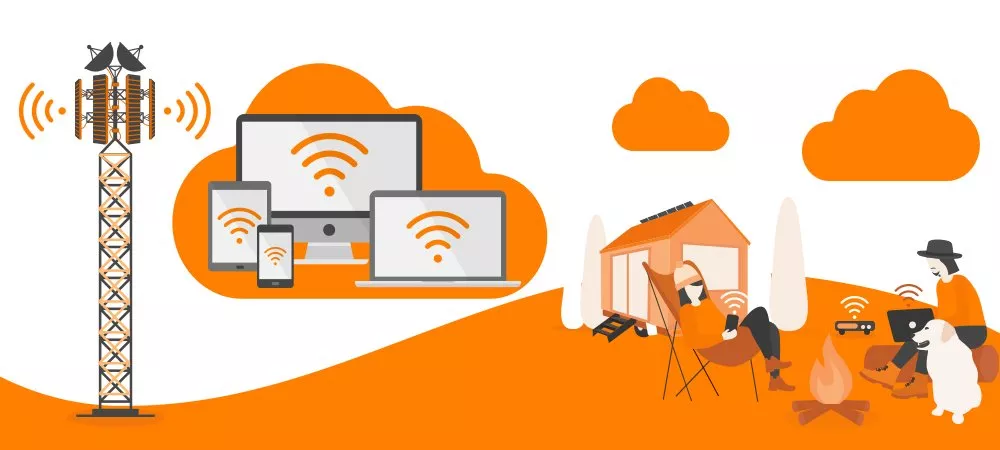Mobile Broadband
Mobile Broadband
*iSelect’s partnered with CIMET to help you compare a range of internet plans and providers. Not all plans or providers in the market are compared and not all plans or special offers are available at all times, through all channels or in all areas. Not all plans available from CIMET’s providers are compared and due to commercial arrangements, area or availability, not all plans compared will be available to all customers. Learn more
Compare NBN plans the easy way
Save time and effort by comparing a range of NBN plans and providers online*
What is Mobile Broadband?
How do I connect to Mobile Broadband?
How does Mobile Broadband work?
What are the benefits of Mobile Broadband?
What’s the difference between 4G and 5G?
What speeds can I get on Mobile Broadband?
Can I get 5G?
Can I use Mobile Broadband overseas?
Is Mobile Broadband more expensive than fixed line Internet?
What’s the difference between prepaid and post-paid Mobile Broadband?
How do I check my Mobile Broadband data usage?
Where can I compare Internet Plans?
What is Mobile Broadband?
Phones became cordless ages ago; it’s about time the Internet did too. And we’re not just talking Wi-Fi at home. Using the same networks that allow you to make phone calls and text pictures of your cat to your best mates, Mobile Broadband lets you stay connected to cyberspace wherever you go (anywhere you can get a signal at least).
There’s no modem, no wires, no discovering you accidentally unplugged the Internet while vacuuming, just the world wide web when and where you want it.
How do I connect to Mobile Broadband?
Getting connected to Mobile Broadband is a plug-and-play experience. You could use a dongle (like a USB stick, just with a funnier name) with your computer’s USB port. Or if you want to set and forget, you could always slip a data-only SIM card into your phone, tablet or dedicated Mobile Broadband modem or wireless hotspot.
Speaking of hotspots, depending on your connection, you can share the Internet through your Mobile Broadband connected device with other nearby tech. This means you can have a complete Internet-connected ecosystem if you’re at home or out and about.
How does Mobile Broadband work?
Mobile Broadband uses mobile networks to get you that precious Internet connection — suddenly, living near a tower doesn’t sound like such a bad thing. But, like mobile reception, your Mobile Broadband needs to go through an Internet Retailer, which means having a plan with them. Otherwise, you won’t be able to access the signal and the Internet.
Your ability to connect to Mobile Broadband will also depend on what the reception is like. For example, while 99% of Australia’s population lives somewhere with mobile coverage,1The Department of Infrastructure, Transport, Regional Development, Communications and the Arts – Mobile services and coverage that actually only extends across about 30% of the country’s land mass.2Nine News – The evolution of 5G: The gamechanger coming to Australian mobile coverage So, probably don’t agree to that Zoom call while you’re crossing the Nullarbor. Even in established coverage areas you can encounter parts or places where it’s tricky to get quite the speed you’re used to. Buildings, trees, bad weather, mountains and even the amount of people using the same tower can make reception spotty.

What are the benefits of Mobile Broadband?
Mobile Broadband and modern-day living go together like chips and chicken salt. With Mobile Broadband, you can:
- Choose an option that suits you, including plans, data allowances and connection set-ups.
- Connect your home Internet in a matter of minutes without the hassle of installation and technician visits.
- Hotspot to share the Mobile Broadband love across devices.
- Back up your wired Home Broadband when there’s disruptions and outages.
- Depending on your location, enjoy fast speeds and connectivity.
What’s the difference between 4G and 5G?
Both 4G and 5G are the latest in a long line of global wireless technologies, but 5G is the youngest and quickest. Each generation of this tech has gotten more advanced and efficient, allowing us to do more with it at home and work. Think of it like going from dial-up Internet to Broadband. We went from files taking all night to download and fights over needing to use the phone to seamless web surfing.
While 4G certainly had its moment in the sun as the latest and greatest mobile tech, 5G is leaving it in the dust. Reliability, speed, capacity and connectivity are all areas this latest generation is set to excel in (if it hasn’t already!)
What speeds can I get on Mobile Broadband?
While signal strength does play a role in whether you get the speed of a champion racehorse or a miniature pony taking off on an unsuspecting child at a school fete, Mobile Broadband offers speeds to suit a range of users. For instance, on 4G you typically can get download speeds of up to 100 Mbps but it is capable of up to 1 Gbps. 5G, as the next generation after all, can take things up a notch with the potential for up to 20 Gbps with remarkably low latency. Of course, you might not always be cruising at such high Internet speeds, but generally your 5G experience promises to be faster than what you got with 4G.
Can I get 5G?
The 5G rollout is well underway. And while it isn’t quite as quick as a boulder chasing Indiana Jones, it’s also a lot less chaotic. As of November 2023, there are more than 9,500 5G sites across Australia, ranging from capital cities to very remote parts of the country. Approximately 84.8% of these are in major cities.3Australian Competition and Consumer Commission – Mobile Infrastructure Report 2023, p12 This is great news if you live in more populous areas, but maybe less so if you live beyond the black stump. However, 95% of the population should be enjoying 5G by 2025, which means if you live more rurally you hopefully won’t be waiting long.
Can I use Mobile Broadband overseas?
The Internet is worldwide and so is Mobile Broadband. This means that you can use it overseas — talk about portable. Of course, it’s a good idea to read the Ts and Cs, particularly as there may be some additional roaming charges involved. You may need to pick up an international data plan also.
Is Mobile Broadband more expensive than fixed line Internet?
When you’re talking costs for Mobile Broadband and fixed-line Internet, like the NBN, it’s really a question of speed and data. Different plans may come with different data limits or they could be unlimited. At the same time, fixed-line plans could be restricted to different speed tiers. The more speed and data you choose, the more you’ll generally be paying, regardless of whether you’re picking Mobile Broadband or fixed-line Internet.
It can help to think about how you use the Internet to narrow in on a plan (and price) that could be a good fit. For instance, if you’re just checking your socials and emails, you would likely need a fair bit less speed and data than someone who has a dedicated weekly World of Warcraft night with their buddies.
What’s the difference between prepaid and post-paid Mobile Broadband?
Essentially post-paid is how your regular old bills are handled. With post-paid, you get to the end of the month (or whatever time frame your provider is using) and you receive a bill with usually a fixed fee and an amount based on how much data you used. This type of billing can be good if you’re not sure how much data you’ll need between bills.
However, if you’re the plan-ahead type, prepaid could be more your style. This way you pay for your Mobile Broadband data before you use it. This will also be for an allotted time, and once time is up (or you’re out of data), it’s time to pull out your wallet again.
How do I check my Mobile Broadband data usage?
You can usually keep an eye on your Mobile Broadband data usage (and decide if maybe you need to stop the weekend-long Netflix binges) through your provider’s online portal or app. There may be a dashboard that lets you view and track your data usage over time or how much data you have left.
Additionally, you may find your devices, like iPhones, have their own data usage trackers you can make use of.
Where can I compare Internet Plans?
If all this Internet chat has gotten you fired up to search for a new plan, you’re in luck. iSelect has partnered with CIMET to make it easy for you to compare a range of Internet Plans and Providers.* You can use our online tool or give our friendly team a call on 13 19 20.

Get started on comparing NBN plans today!
Save time and effort by comparing a range of NBN plans and providers online*

.svg)




